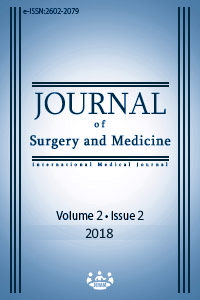The influence of anemia on maternal and neonatal outcomes in adolescent pregnant
Keywords:
Adolescent, Pregnancy, Anemia, Outcome, PostpartumAbstract
Downloads
References
McLean E, Cogswell M, Egli I, et al. “Worldwide prevalence of anaemia, WHO Vitamin and Mineral Nutrition Information System, 1993–2005” Public Health Nutrition 2009; 12(4); pp. 444–454.
WHO/UNICEF/UNU. Iron deficiency anaemia: assessment, prevention and control. Geneva: World Health Organization 2001. WHO/NHD/01.3.
Adolescent Pregnancy. World Health Organisation; Department of Making Pregnancy Safer. Geneva; 2008.
World population prospects: the 2010 revision. New York: United Nations, Department of Economic and Social Affairs; 2010.
Turkey Demographic Health Survey 2013. Hacettepe University Institute of Population Studies, Ankara, Turkey.
Banerjee B, Pandey G, Dutt D, et al. Teenage pregnancy: a socially inflicted health hazard. Indian J Community Med. 2009 Jul;34(3);227-31.
Levy A, Fraser D, Katz M, et al. Maternal anemia during pregnancy is an independent risk factor for low birth¬weight and preterm delivery. Eur J Obstet Gynecol Reprod Biol. 2005;122(2);182–6.
Sukrat B, Wilasrusmee C, Siribumrungwong B, et al. Hemoglobin Concentration and Pregnancy Outcomes: A Systematic Review and Meta-Analysis. BioMed Res Int. 2013;769057.
Zhang Q, Ananth CV, Li Z, et al. Maternal anaemia and preterm birth: a prospective cohort study. Int J Epidemiol. 2009;38(5);1380-9.
Oteng-Ntim E, Meeks D, Seed PT, et al. Adverse maternal and perinatal outcomes in pregnant women with sickle cell disease: systematic review and meta-analysis. Blood. 2015;125(21);3316-25.
Masukume G, Khashan AS, Kenny LC, et al. SCOPE Consortium. Risk factors and birth outcomes of anaemia in early pregnancy in a nulliparous cohort. PLoS One. 2015;10(4);e0122729.
Jans SM, de Jonge A, Lagro-Janssen AL. Maternal and perinatal outcomes amongst haemoglobinopathy carriers: a systematic review. Int J Clin Pract. 2010;64(12);1688-98.
World Health Organization. Adolescent pregnancy. WHO; 2013. http://www.who.int/maternal_child_adolescent/topics/maternal/adolescent_pregnancy/en/index.html
Department of Nutrition for Health and Development (NHD) World Health Organization. Haemoglobin concentrations for the diagnosis of anaemia and assessment of severity. Geneva, 2011.
American College of Obtetricians and Gynecologists (ACOG). Hypertension in Pregnancy. Task Force Hypertension in Pregnancy; 2013. pp.13
World Health Organization. WHA Global Nutrition Targets 2025: Anaemia Policy Brief. Geneva, 2014.
World Health Organization. Early marriages, adolescent and young pregnancies. Report by the Secretariat. Sixty-Fifth World Health Assembly. 2012.
Omar K, Hasim S, Muhammad NA, et al. Adolescent pregnancy outcomes and risk factors in Malaysia. Int J Gynaecol Obstet. 2010;111(3);220-3.
UNFPA, Motherhood in childhood: Facing the challenge of adolescent pregnancy: The State of World Population 2013. New York:United Nations Population Fund.
Singh S. Adolescent childbearing in developing countries: a global review. Stud Fam Plann. 1998;29(2);117-36.
Simkhada B, Teijlingen ER, Porter M, et al. Factors affecting the utilization of antenatal care in developing countries: systematic review of the literature. J Adv Nurs. 2008;61(3);244-60.
Ikeanyi EM, Ibrahim Al. Does antenatal care attendance prevent anemia in pregnancy at term? Niger J Clin Pract. 2015;18(3);323-7.
Frass AK. Postpartum hemorrhage is related to the hemoglobin levels at labor: Observational study. Alexandria Journal of Medicine 2015; 51;333–337.
Rukuni R, Bhattacharya S, Murphy MF, et al. Maternal and neonatal outcomes of antenatal anemia in a Scottish population: a retrospective cohort study. Acta Obstet Gynecol Scand. 2016;95(5);555-64.
Pun KD, Chauhan M. Outcome of adolescent pregnancy at Kathmandu University Hospital, Dhulikhel, Kavre. Kathmandu Univ Med J (KUMJ). 2011 Jan-Mar;9(33):50-3.
Conde-Agudelo A, Belizan JM, Lammers C. Maternal-perinatal morbidity and mortality associated with adolescent pregnancy in Latin America: Cross-sectional study. Am J Obstet Gynecol. 2005;192(2);342-9.
Drukker L, Hants Y, Farkash R et al. Iron deficiency anemia at admission for labor and delivery is associated with an increased risk for Cesarean section and adverse maternal and neonatal outcomes. Transfusion. 2015;55(12);2799-806.
Raisanen S, Kancherla V, Gissler M et al. Adverse perinatal outcomes associated with moderate or severe maternal anaemia based on parity in Finland during 2006-10. Paediatr Perinat Epidemiol. 2014;28(5);372-80.
Dutta I, Joshi P. Maternal and perinatal outcome in teenage vs. Vicenarian primigravidae-a clinical study. J Clin Diagn Res. 2013;7(12);2881-4.
Rosenstock A, van Manen M. Adolescent parenting in the neonatal intensive care unit. J Adolesc Health. 2014;55(6);723-9.
Downloads
- 3112 3751
Published
Issue
Section
How to Cite
License
Copyright (c) 2018 Elif Yılmaz, Ozlem Yazıcı Işıtan, Çağanay Soysal, Zehra Vural Yılmaz, Osman Fadıl Kara, Tuncay Küçüközkan
This work is licensed under a Creative Commons Attribution-NonCommercial-NoDerivatives 4.0 International License.















